Reflective Essay: Driscoll Model and Mental Health Nursing Practice
VerifiedAdded on 2022/08/14
|9
|2383
|19
Essay
AI Summary
This reflective essay, authored by a student nurse, details a clinical incident encountered during a placement in a mental health ward. The essay utilizes the Driscoll model to analyze the experience of assessing a patient, Ms. Anjali, who presented with a history of substance abuse, cannabis-induced psychosis, and non-compliance with medication, leading to self-harm behaviors and the risk of refeeding syndrome. The student reflects on the challenges of patient assessment, the importance of effective communication, and the identification of potential risks such as self-harm and metabolic disorders. The essay explores the application of evidence-based interventions, including psychotherapy and intravenous electrolyte replacement, and discusses the student's personal and professional growth, highlighting the need for further training in patient-centered care and self-harm management. The paper concludes with a reflection on the learnings from the incident and the implications for future nursing practice, emphasizing the significance of reflective practice in clinical settings.
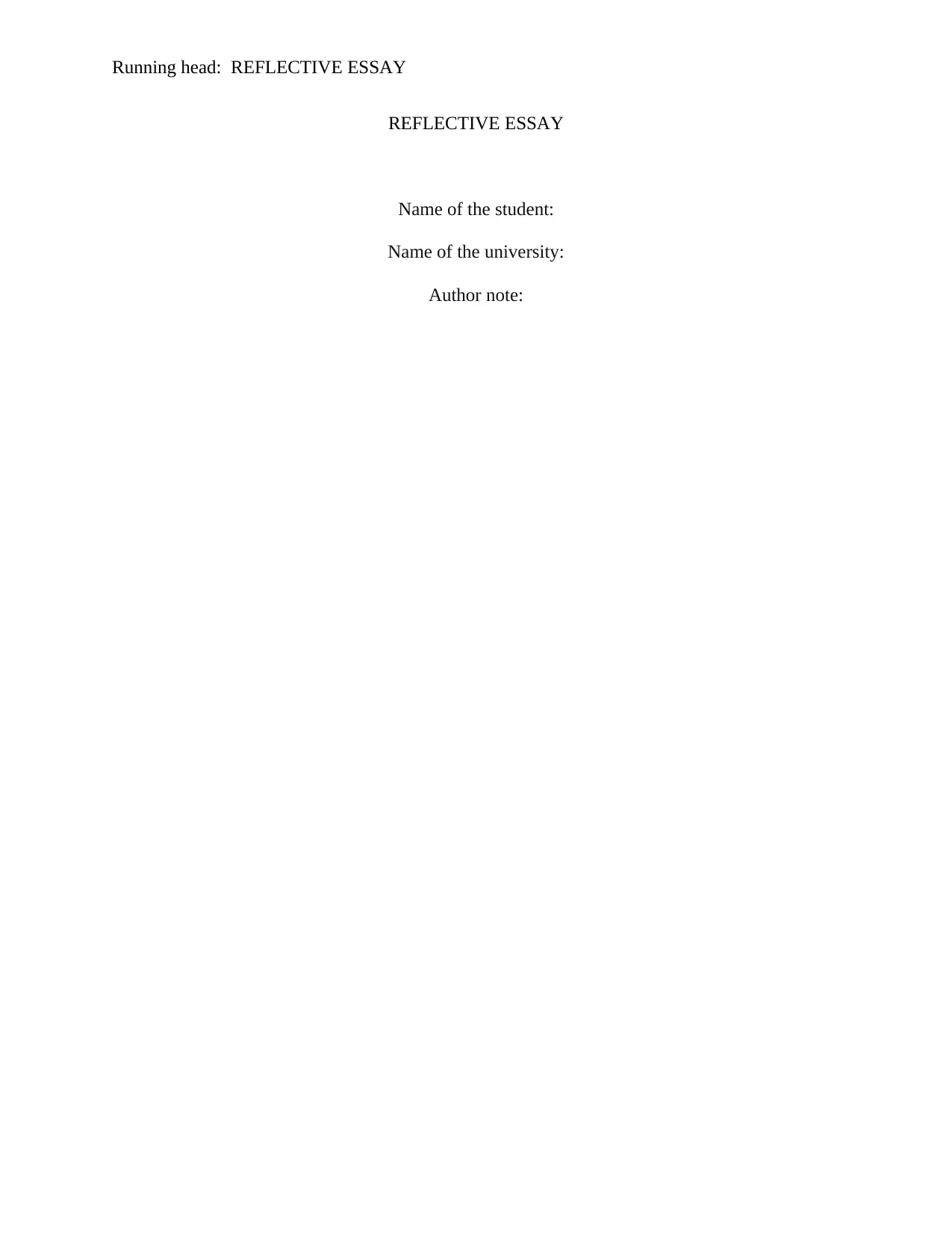
Running head: REFLECTIVE ESSAY
REFLECTIVE ESSAY
Name of the student:
Name of the university:
Author note:
REFLECTIVE ESSAY
Name of the student:
Name of the university:
Author note:
Paraphrase This Document
Need a fresh take? Get an instant paraphrase of this document with our AI Paraphraser
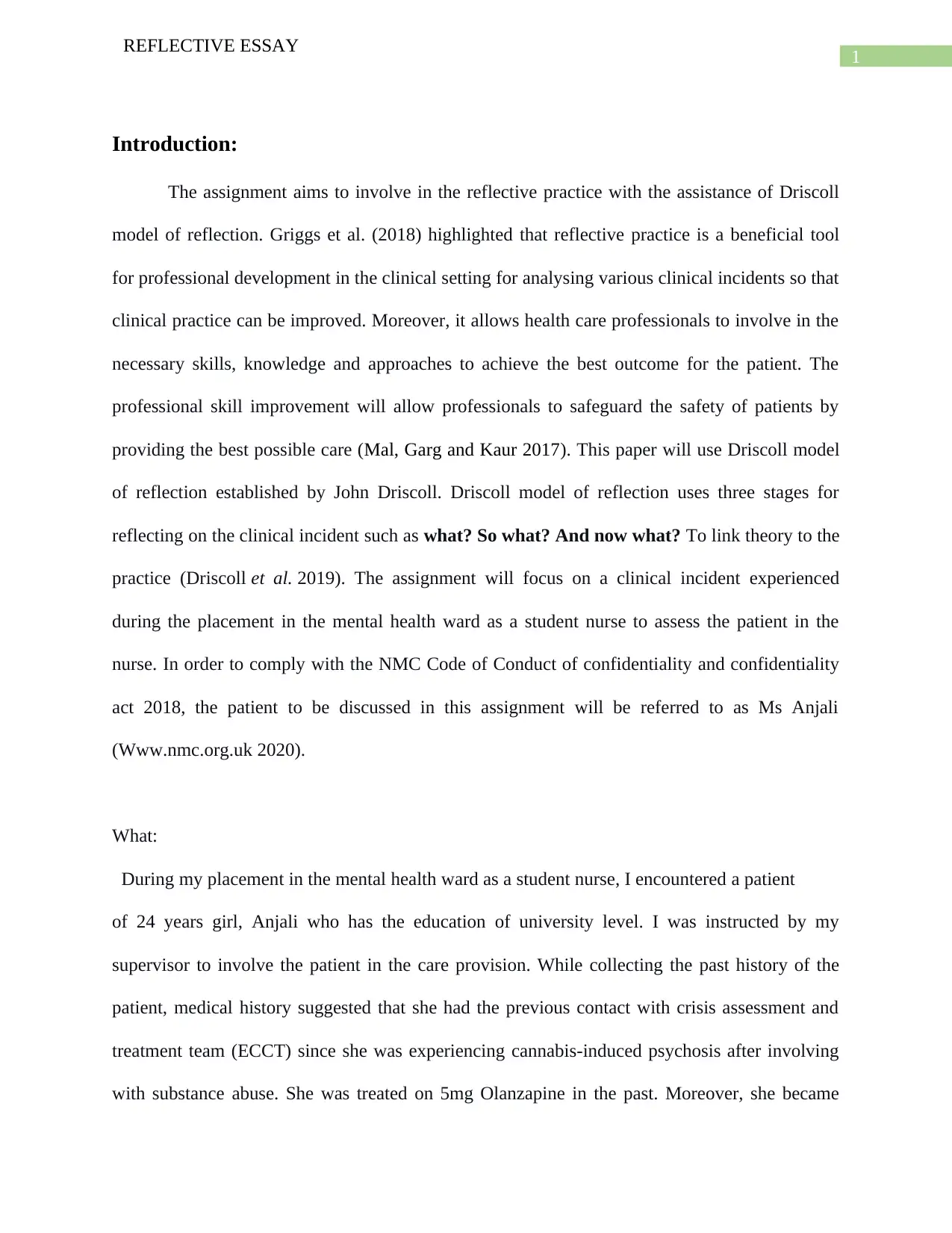
1
REFLECTIVE ESSAY
Introduction:
The assignment aims to involve in the reflective practice with the assistance of Driscoll
model of reflection. Griggs et al. (2018) highlighted that reflective practice is a beneficial tool
for professional development in the clinical setting for analysing various clinical incidents so that
clinical practice can be improved. Moreover, it allows health care professionals to involve in the
necessary skills, knowledge and approaches to achieve the best outcome for the patient. The
professional skill improvement will allow professionals to safeguard the safety of patients by
providing the best possible care (Mal, Garg and Kaur 2017). This paper will use Driscoll model
of reflection established by John Driscoll. Driscoll model of reflection uses three stages for
reflecting on the clinical incident such as what? So what? And now what? To link theory to the
practice (Driscoll et al. 2019). The assignment will focus on a clinical incident experienced
during the placement in the mental health ward as a student nurse to assess the patient in the
nurse. In order to comply with the NMC Code of Conduct of confidentiality and confidentiality
act 2018, the patient to be discussed in this assignment will be referred to as Ms Anjali
(Www.nmc.org.uk 2020).
What:
During my placement in the mental health ward as a student nurse, I encountered a patient
of 24 years girl, Anjali who has the education of university level. I was instructed by my
supervisor to involve the patient in the care provision. While collecting the past history of the
patient, medical history suggested that she had the previous contact with crisis assessment and
treatment team (ECCT) since she was experiencing cannabis-induced psychosis after involving
with substance abuse. She was treated on 5mg Olanzapine in the past. Moreover, she became
REFLECTIVE ESSAY
Introduction:
The assignment aims to involve in the reflective practice with the assistance of Driscoll
model of reflection. Griggs et al. (2018) highlighted that reflective practice is a beneficial tool
for professional development in the clinical setting for analysing various clinical incidents so that
clinical practice can be improved. Moreover, it allows health care professionals to involve in the
necessary skills, knowledge and approaches to achieve the best outcome for the patient. The
professional skill improvement will allow professionals to safeguard the safety of patients by
providing the best possible care (Mal, Garg and Kaur 2017). This paper will use Driscoll model
of reflection established by John Driscoll. Driscoll model of reflection uses three stages for
reflecting on the clinical incident such as what? So what? And now what? To link theory to the
practice (Driscoll et al. 2019). The assignment will focus on a clinical incident experienced
during the placement in the mental health ward as a student nurse to assess the patient in the
nurse. In order to comply with the NMC Code of Conduct of confidentiality and confidentiality
act 2018, the patient to be discussed in this assignment will be referred to as Ms Anjali
(Www.nmc.org.uk 2020).
What:
During my placement in the mental health ward as a student nurse, I encountered a patient
of 24 years girl, Anjali who has the education of university level. I was instructed by my
supervisor to involve the patient in the care provision. While collecting the past history of the
patient, medical history suggested that she had the previous contact with crisis assessment and
treatment team (ECCT) since she was experiencing cannabis-induced psychosis after involving
with substance abuse. She was treated on 5mg Olanzapine in the past. Moreover, she became
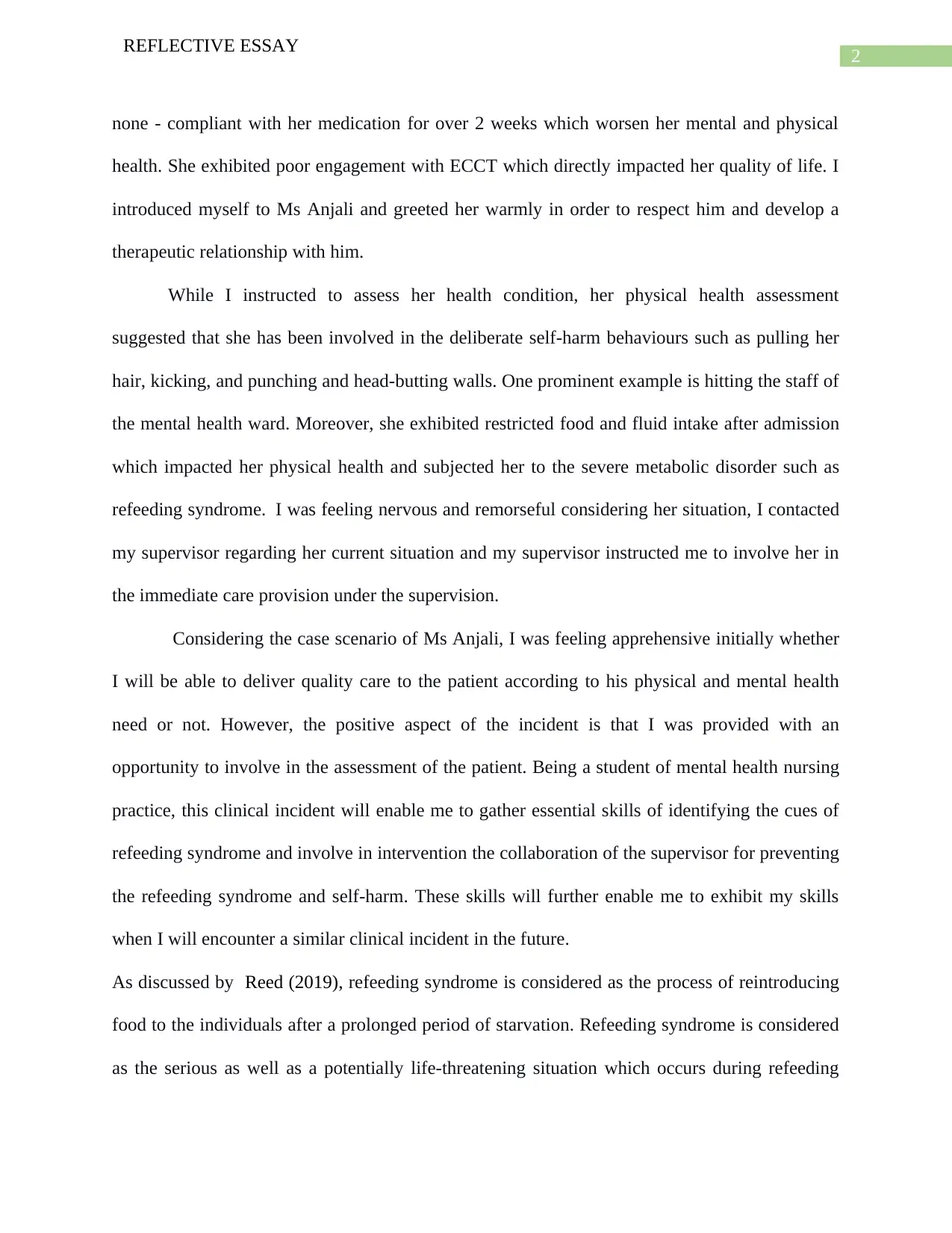
2
REFLECTIVE ESSAY
none - compliant with her medication for over 2 weeks which worsen her mental and physical
health. She exhibited poor engagement with ECCT which directly impacted her quality of life. I
introduced myself to Ms Anjali and greeted her warmly in order to respect him and develop a
therapeutic relationship with him.
While I instructed to assess her health condition, her physical health assessment
suggested that she has been involved in the deliberate self-harm behaviours such as pulling her
hair, kicking, and punching and head-butting walls. One prominent example is hitting the staff of
the mental health ward. Moreover, she exhibited restricted food and fluid intake after admission
which impacted her physical health and subjected her to the severe metabolic disorder such as
refeeding syndrome. I was feeling nervous and remorseful considering her situation, I contacted
my supervisor regarding her current situation and my supervisor instructed me to involve her in
the immediate care provision under the supervision.
Considering the case scenario of Ms Anjali, I was feeling apprehensive initially whether
I will be able to deliver quality care to the patient according to his physical and mental health
need or not. However, the positive aspect of the incident is that I was provided with an
opportunity to involve in the assessment of the patient. Being a student of mental health nursing
practice, this clinical incident will enable me to gather essential skills of identifying the cues of
refeeding syndrome and involve in intervention the collaboration of the supervisor for preventing
the refeeding syndrome and self-harm. These skills will further enable me to exhibit my skills
when I will encounter a similar clinical incident in the future.
As discussed by Reed (2019), refeeding syndrome is considered as the process of reintroducing
food to the individuals after a prolonged period of starvation. Refeeding syndrome is considered
as the serious as well as a potentially life-threatening situation which occurs during refeeding
REFLECTIVE ESSAY
none - compliant with her medication for over 2 weeks which worsen her mental and physical
health. She exhibited poor engagement with ECCT which directly impacted her quality of life. I
introduced myself to Ms Anjali and greeted her warmly in order to respect him and develop a
therapeutic relationship with him.
While I instructed to assess her health condition, her physical health assessment
suggested that she has been involved in the deliberate self-harm behaviours such as pulling her
hair, kicking, and punching and head-butting walls. One prominent example is hitting the staff of
the mental health ward. Moreover, she exhibited restricted food and fluid intake after admission
which impacted her physical health and subjected her to the severe metabolic disorder such as
refeeding syndrome. I was feeling nervous and remorseful considering her situation, I contacted
my supervisor regarding her current situation and my supervisor instructed me to involve her in
the immediate care provision under the supervision.
Considering the case scenario of Ms Anjali, I was feeling apprehensive initially whether
I will be able to deliver quality care to the patient according to his physical and mental health
need or not. However, the positive aspect of the incident is that I was provided with an
opportunity to involve in the assessment of the patient. Being a student of mental health nursing
practice, this clinical incident will enable me to gather essential skills of identifying the cues of
refeeding syndrome and involve in intervention the collaboration of the supervisor for preventing
the refeeding syndrome and self-harm. These skills will further enable me to exhibit my skills
when I will encounter a similar clinical incident in the future.
As discussed by Reed (2019), refeeding syndrome is considered as the process of reintroducing
food to the individuals after a prolonged period of starvation. Refeeding syndrome is considered
as the serious as well as a potentially life-threatening situation which occurs during refeeding
⊘ This is a preview!⊘
Do you want full access?
Subscribe today to unlock all pages.

Trusted by 1+ million students worldwide
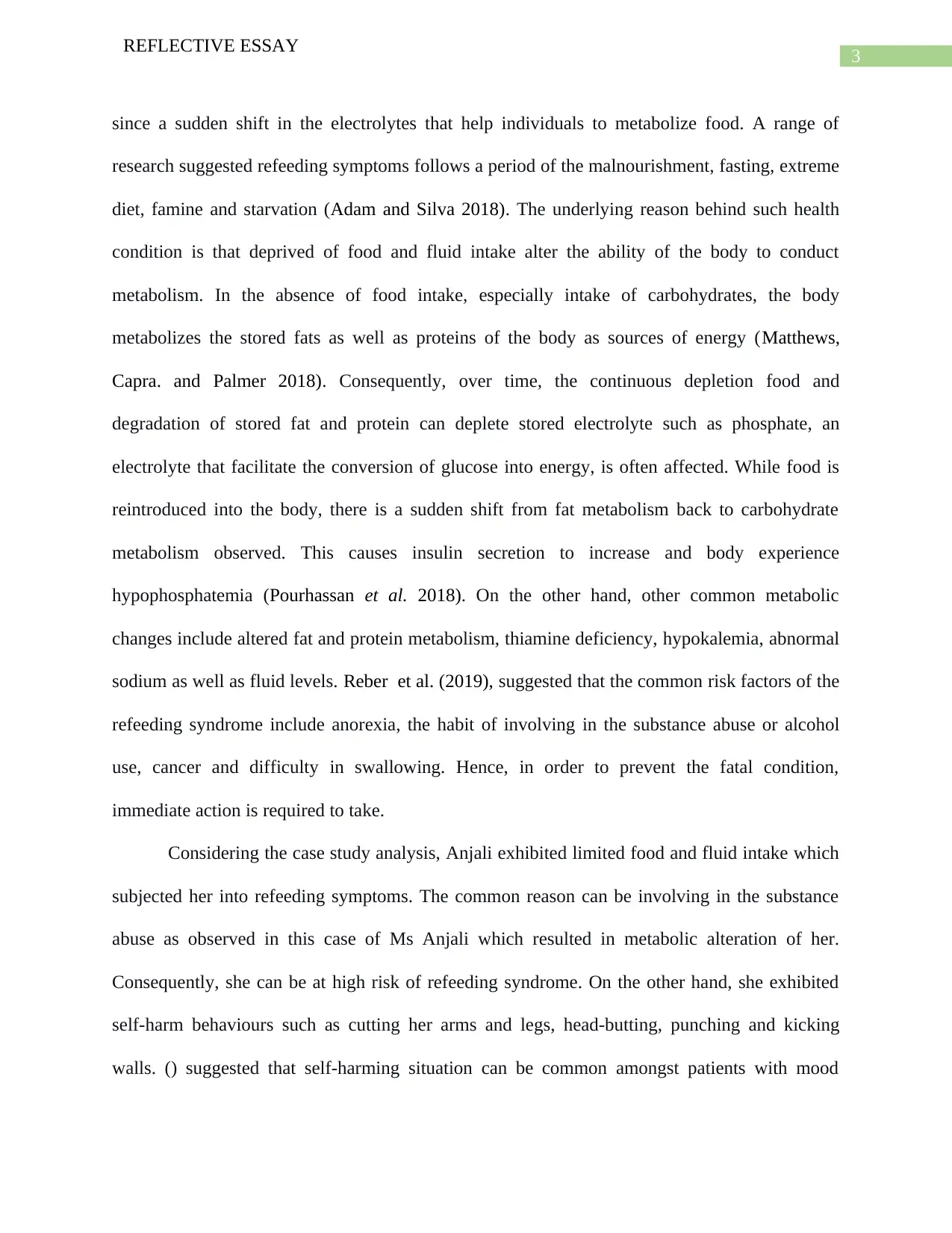
3
REFLECTIVE ESSAY
since a sudden shift in the electrolytes that help individuals to metabolize food. A range of
research suggested refeeding symptoms follows a period of the malnourishment, fasting, extreme
diet, famine and starvation (Adam and Silva 2018). The underlying reason behind such health
condition is that deprived of food and fluid intake alter the ability of the body to conduct
metabolism. In the absence of food intake, especially intake of carbohydrates, the body
metabolizes the stored fats as well as proteins of the body as sources of energy (Matthews,
Capra. and Palmer 2018). Consequently, over time, the continuous depletion food and
degradation of stored fat and protein can deplete stored electrolyte such as phosphate, an
electrolyte that facilitate the conversion of glucose into energy, is often affected. While food is
reintroduced into the body, there is a sudden shift from fat metabolism back to carbohydrate
metabolism observed. This causes insulin secretion to increase and body experience
hypophosphatemia (Pourhassan et al. 2018). On the other hand, other common metabolic
changes include altered fat and protein metabolism, thiamine deficiency, hypokalemia, abnormal
sodium as well as fluid levels. Reber et al. (2019), suggested that the common risk factors of the
refeeding syndrome include anorexia, the habit of involving in the substance abuse or alcohol
use, cancer and difficulty in swallowing. Hence, in order to prevent the fatal condition,
immediate action is required to take.
Considering the case study analysis, Anjali exhibited limited food and fluid intake which
subjected her into refeeding symptoms. The common reason can be involving in the substance
abuse as observed in this case of Ms Anjali which resulted in metabolic alteration of her.
Consequently, she can be at high risk of refeeding syndrome. On the other hand, she exhibited
self-harm behaviours such as cutting her arms and legs, head-butting, punching and kicking
walls. () suggested that self-harming situation can be common amongst patients with mood
REFLECTIVE ESSAY
since a sudden shift in the electrolytes that help individuals to metabolize food. A range of
research suggested refeeding symptoms follows a period of the malnourishment, fasting, extreme
diet, famine and starvation (Adam and Silva 2018). The underlying reason behind such health
condition is that deprived of food and fluid intake alter the ability of the body to conduct
metabolism. In the absence of food intake, especially intake of carbohydrates, the body
metabolizes the stored fats as well as proteins of the body as sources of energy (Matthews,
Capra. and Palmer 2018). Consequently, over time, the continuous depletion food and
degradation of stored fat and protein can deplete stored electrolyte such as phosphate, an
electrolyte that facilitate the conversion of glucose into energy, is often affected. While food is
reintroduced into the body, there is a sudden shift from fat metabolism back to carbohydrate
metabolism observed. This causes insulin secretion to increase and body experience
hypophosphatemia (Pourhassan et al. 2018). On the other hand, other common metabolic
changes include altered fat and protein metabolism, thiamine deficiency, hypokalemia, abnormal
sodium as well as fluid levels. Reber et al. (2019), suggested that the common risk factors of the
refeeding syndrome include anorexia, the habit of involving in the substance abuse or alcohol
use, cancer and difficulty in swallowing. Hence, in order to prevent the fatal condition,
immediate action is required to take.
Considering the case study analysis, Anjali exhibited limited food and fluid intake which
subjected her into refeeding symptoms. The common reason can be involving in the substance
abuse as observed in this case of Ms Anjali which resulted in metabolic alteration of her.
Consequently, she can be at high risk of refeeding syndrome. On the other hand, she exhibited
self-harm behaviours such as cutting her arms and legs, head-butting, punching and kicking
walls. () suggested that self-harming situation can be common amongst patients with mood
Paraphrase This Document
Need a fresh take? Get an instant paraphrase of this document with our AI Paraphraser
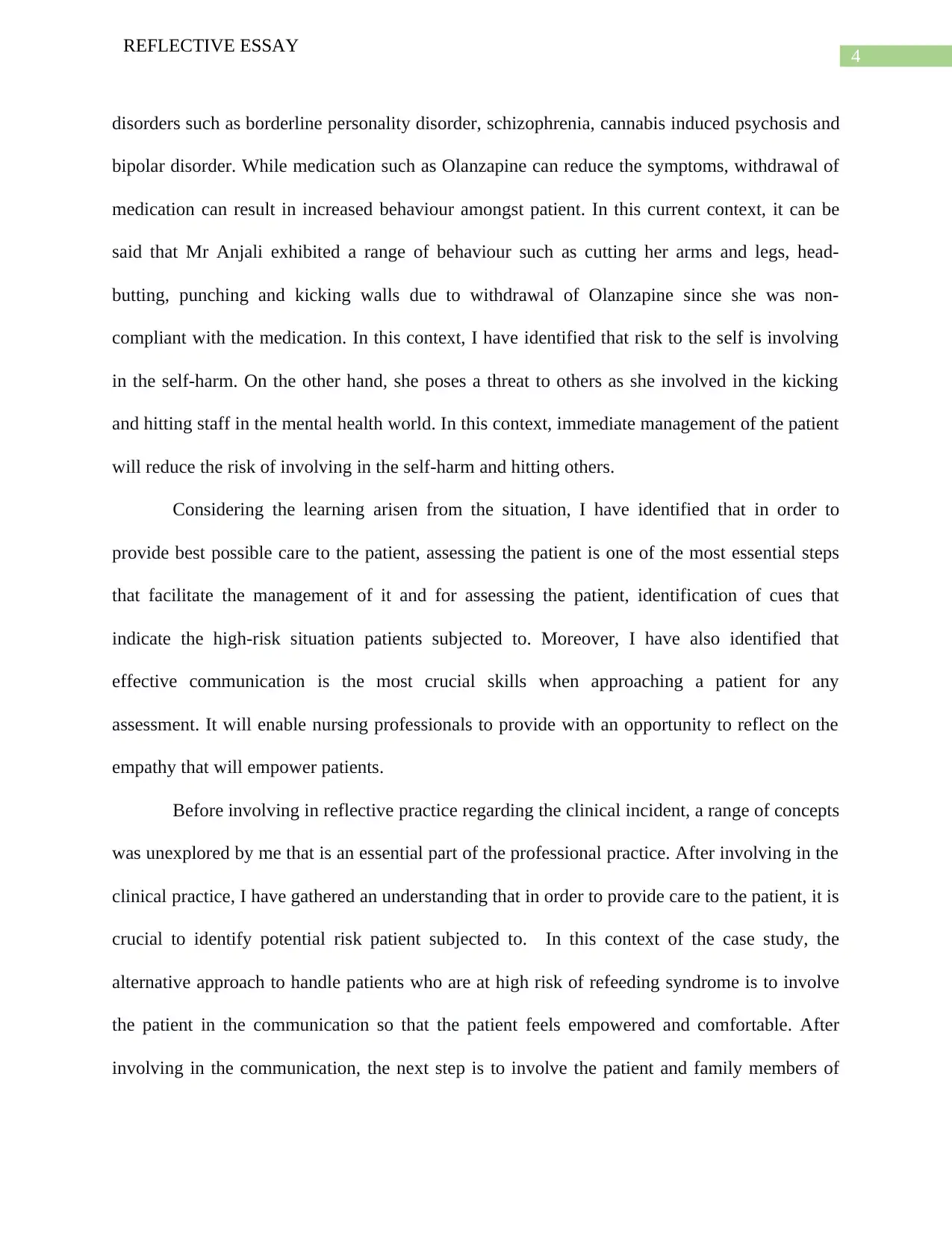
4
REFLECTIVE ESSAY
disorders such as borderline personality disorder, schizophrenia, cannabis induced psychosis and
bipolar disorder. While medication such as Olanzapine can reduce the symptoms, withdrawal of
medication can result in increased behaviour amongst patient. In this current context, it can be
said that Mr Anjali exhibited a range of behaviour such as cutting her arms and legs, head-
butting, punching and kicking walls due to withdrawal of Olanzapine since she was non-
compliant with the medication. In this context, I have identified that risk to the self is involving
in the self-harm. On the other hand, she poses a threat to others as she involved in the kicking
and hitting staff in the mental health world. In this context, immediate management of the patient
will reduce the risk of involving in the self-harm and hitting others.
Considering the learning arisen from the situation, I have identified that in order to
provide best possible care to the patient, assessing the patient is one of the most essential steps
that facilitate the management of it and for assessing the patient, identification of cues that
indicate the high-risk situation patients subjected to. Moreover, I have also identified that
effective communication is the most crucial skills when approaching a patient for any
assessment. It will enable nursing professionals to provide with an opportunity to reflect on the
empathy that will empower patients.
Before involving in reflective practice regarding the clinical incident, a range of concepts
was unexplored by me that is an essential part of the professional practice. After involving in the
clinical practice, I have gathered an understanding that in order to provide care to the patient, it is
crucial to identify potential risk patient subjected to. In this context of the case study, the
alternative approach to handle patients who are at high risk of refeeding syndrome is to involve
the patient in the communication so that the patient feels empowered and comfortable. After
involving in the communication, the next step is to involve the patient and family members of
REFLECTIVE ESSAY
disorders such as borderline personality disorder, schizophrenia, cannabis induced psychosis and
bipolar disorder. While medication such as Olanzapine can reduce the symptoms, withdrawal of
medication can result in increased behaviour amongst patient. In this current context, it can be
said that Mr Anjali exhibited a range of behaviour such as cutting her arms and legs, head-
butting, punching and kicking walls due to withdrawal of Olanzapine since she was non-
compliant with the medication. In this context, I have identified that risk to the self is involving
in the self-harm. On the other hand, she poses a threat to others as she involved in the kicking
and hitting staff in the mental health world. In this context, immediate management of the patient
will reduce the risk of involving in the self-harm and hitting others.
Considering the learning arisen from the situation, I have identified that in order to
provide best possible care to the patient, assessing the patient is one of the most essential steps
that facilitate the management of it and for assessing the patient, identification of cues that
indicate the high-risk situation patients subjected to. Moreover, I have also identified that
effective communication is the most crucial skills when approaching a patient for any
assessment. It will enable nursing professionals to provide with an opportunity to reflect on the
empathy that will empower patients.
Before involving in reflective practice regarding the clinical incident, a range of concepts
was unexplored by me that is an essential part of the professional practice. After involving in the
clinical practice, I have gathered an understanding that in order to provide care to the patient, it is
crucial to identify potential risk patient subjected to. In this context of the case study, the
alternative approach to handle patients who are at high risk of refeeding syndrome is to involve
the patient in the communication so that the patient feels empowered and comfortable. After
involving in the communication, the next step is to involve the patient and family members of
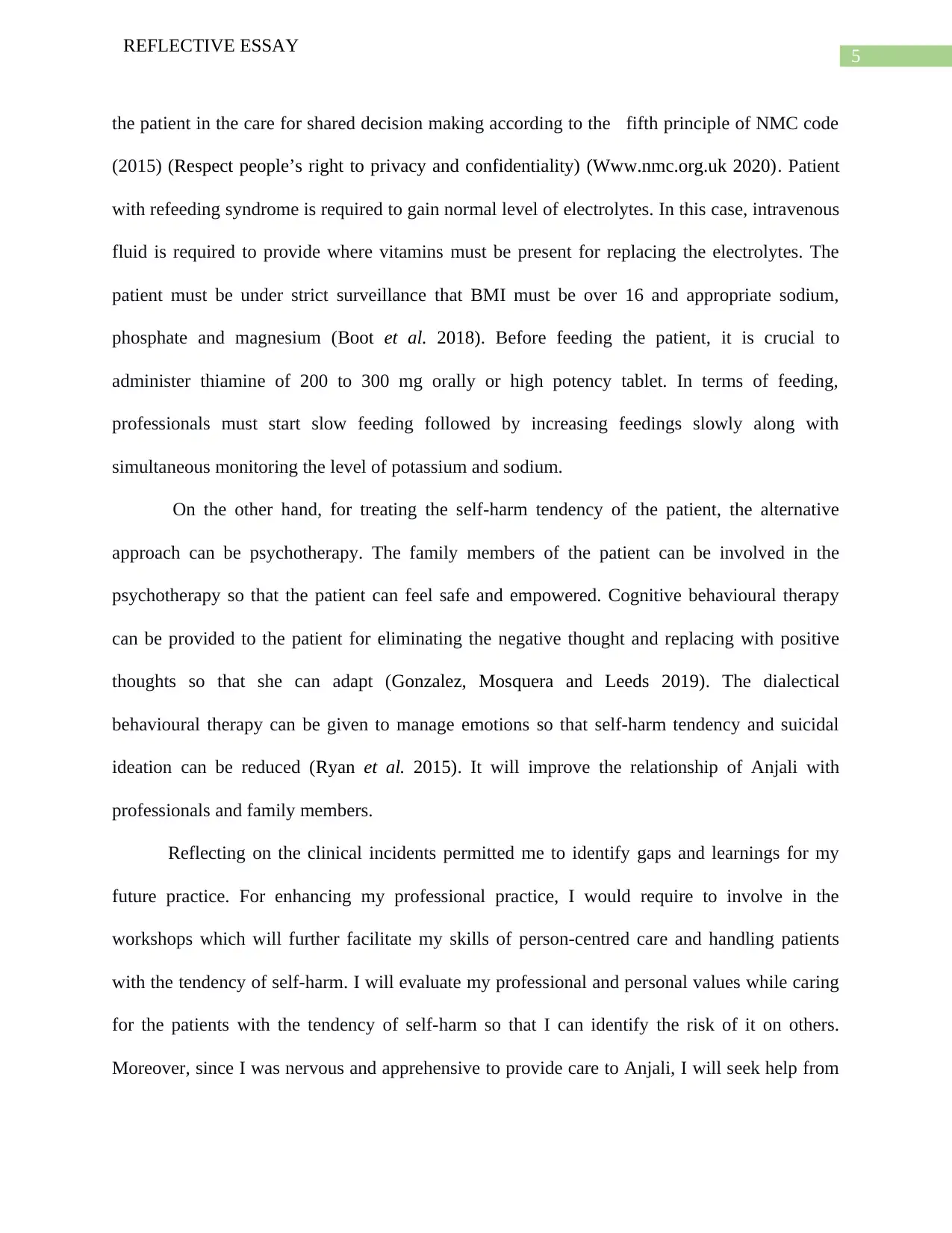
5
REFLECTIVE ESSAY
the patient in the care for shared decision making according to the fifth principle of NMC code
(2015) (Respect people’s right to privacy and confidentiality) (Www.nmc.org.uk 2020). Patient
with refeeding syndrome is required to gain normal level of electrolytes. In this case, intravenous
fluid is required to provide where vitamins must be present for replacing the electrolytes. The
patient must be under strict surveillance that BMI must be over 16 and appropriate sodium,
phosphate and magnesium (Boot et al. 2018). Before feeding the patient, it is crucial to
administer thiamine of 200 to 300 mg orally or high potency tablet. In terms of feeding,
professionals must start slow feeding followed by increasing feedings slowly along with
simultaneous monitoring the level of potassium and sodium.
On the other hand, for treating the self-harm tendency of the patient, the alternative
approach can be psychotherapy. The family members of the patient can be involved in the
psychotherapy so that the patient can feel safe and empowered. Cognitive behavioural therapy
can be provided to the patient for eliminating the negative thought and replacing with positive
thoughts so that she can adapt (Gonzalez, Mosquera and Leeds 2019). The dialectical
behavioural therapy can be given to manage emotions so that self-harm tendency and suicidal
ideation can be reduced (Ryan et al. 2015). It will improve the relationship of Anjali with
professionals and family members.
Reflecting on the clinical incidents permitted me to identify gaps and learnings for my
future practice. For enhancing my professional practice, I would require to involve in the
workshops which will further facilitate my skills of person-centred care and handling patients
with the tendency of self-harm. I will evaluate my professional and personal values while caring
for the patients with the tendency of self-harm so that I can identify the risk of it on others.
Moreover, since I was nervous and apprehensive to provide care to Anjali, I will seek help from
REFLECTIVE ESSAY
the patient in the care for shared decision making according to the fifth principle of NMC code
(2015) (Respect people’s right to privacy and confidentiality) (Www.nmc.org.uk 2020). Patient
with refeeding syndrome is required to gain normal level of electrolytes. In this case, intravenous
fluid is required to provide where vitamins must be present for replacing the electrolytes. The
patient must be under strict surveillance that BMI must be over 16 and appropriate sodium,
phosphate and magnesium (Boot et al. 2018). Before feeding the patient, it is crucial to
administer thiamine of 200 to 300 mg orally or high potency tablet. In terms of feeding,
professionals must start slow feeding followed by increasing feedings slowly along with
simultaneous monitoring the level of potassium and sodium.
On the other hand, for treating the self-harm tendency of the patient, the alternative
approach can be psychotherapy. The family members of the patient can be involved in the
psychotherapy so that the patient can feel safe and empowered. Cognitive behavioural therapy
can be provided to the patient for eliminating the negative thought and replacing with positive
thoughts so that she can adapt (Gonzalez, Mosquera and Leeds 2019). The dialectical
behavioural therapy can be given to manage emotions so that self-harm tendency and suicidal
ideation can be reduced (Ryan et al. 2015). It will improve the relationship of Anjali with
professionals and family members.
Reflecting on the clinical incidents permitted me to identify gaps and learnings for my
future practice. For enhancing my professional practice, I would require to involve in the
workshops which will further facilitate my skills of person-centred care and handling patients
with the tendency of self-harm. I will evaluate my professional and personal values while caring
for the patients with the tendency of self-harm so that I can identify the risk of it on others.
Moreover, since I was nervous and apprehensive to provide care to Anjali, I will seek help from
⊘ This is a preview!⊘
Do you want full access?
Subscribe today to unlock all pages.

Trusted by 1+ million students worldwide
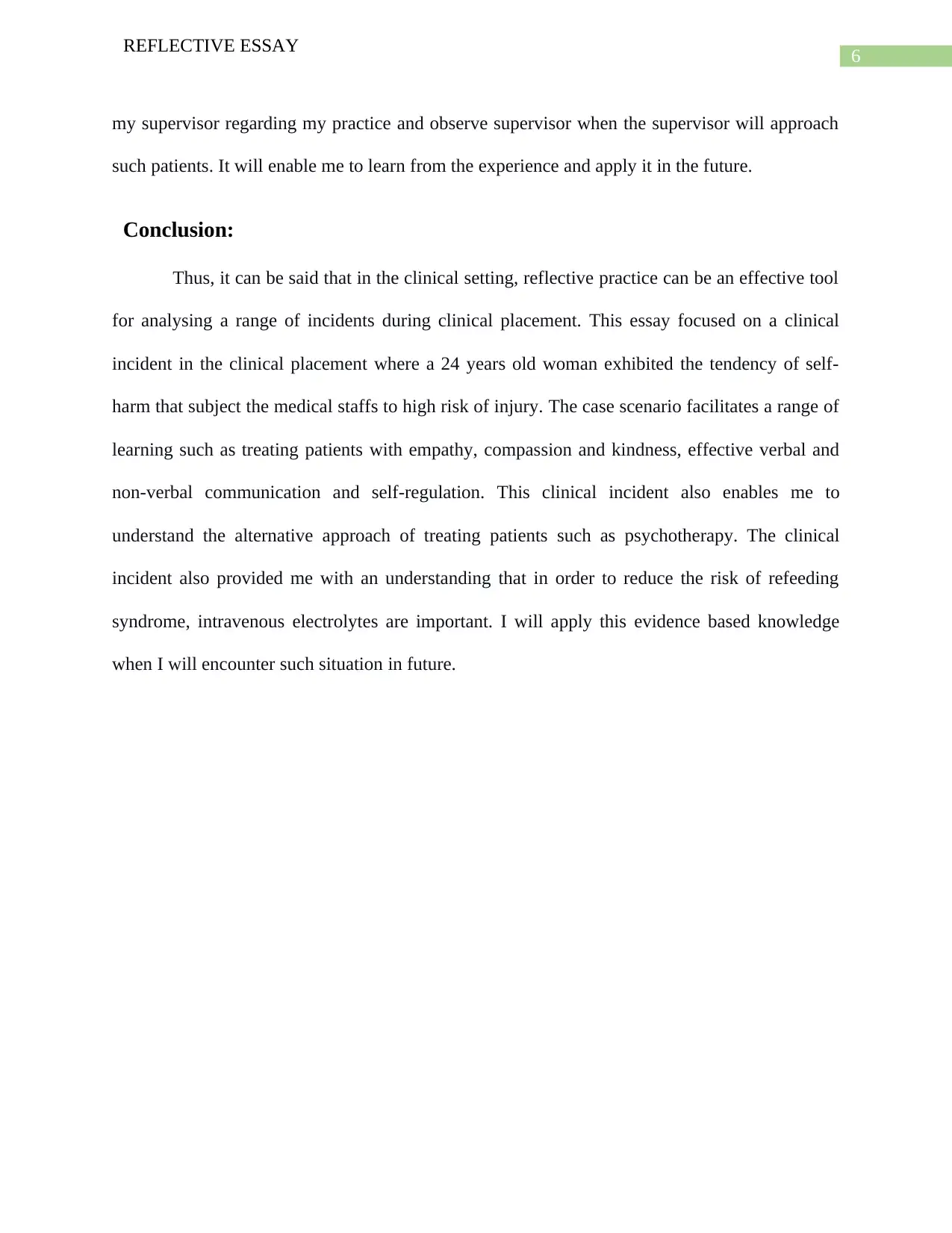
6
REFLECTIVE ESSAY
my supervisor regarding my practice and observe supervisor when the supervisor will approach
such patients. It will enable me to learn from the experience and apply it in the future.
Conclusion:
Thus, it can be said that in the clinical setting, reflective practice can be an effective tool
for analysing a range of incidents during clinical placement. This essay focused on a clinical
incident in the clinical placement where a 24 years old woman exhibited the tendency of self-
harm that subject the medical staffs to high risk of injury. The case scenario facilitates a range of
learning such as treating patients with empathy, compassion and kindness, effective verbal and
non-verbal communication and self-regulation. This clinical incident also enables me to
understand the alternative approach of treating patients such as psychotherapy. The clinical
incident also provided me with an understanding that in order to reduce the risk of refeeding
syndrome, intravenous electrolytes are important. I will apply this evidence based knowledge
when I will encounter such situation in future.
REFLECTIVE ESSAY
my supervisor regarding my practice and observe supervisor when the supervisor will approach
such patients. It will enable me to learn from the experience and apply it in the future.
Conclusion:
Thus, it can be said that in the clinical setting, reflective practice can be an effective tool
for analysing a range of incidents during clinical placement. This essay focused on a clinical
incident in the clinical placement where a 24 years old woman exhibited the tendency of self-
harm that subject the medical staffs to high risk of injury. The case scenario facilitates a range of
learning such as treating patients with empathy, compassion and kindness, effective verbal and
non-verbal communication and self-regulation. This clinical incident also enables me to
understand the alternative approach of treating patients such as psychotherapy. The clinical
incident also provided me with an understanding that in order to reduce the risk of refeeding
syndrome, intravenous electrolytes are important. I will apply this evidence based knowledge
when I will encounter such situation in future.
Paraphrase This Document
Need a fresh take? Get an instant paraphrase of this document with our AI Paraphraser
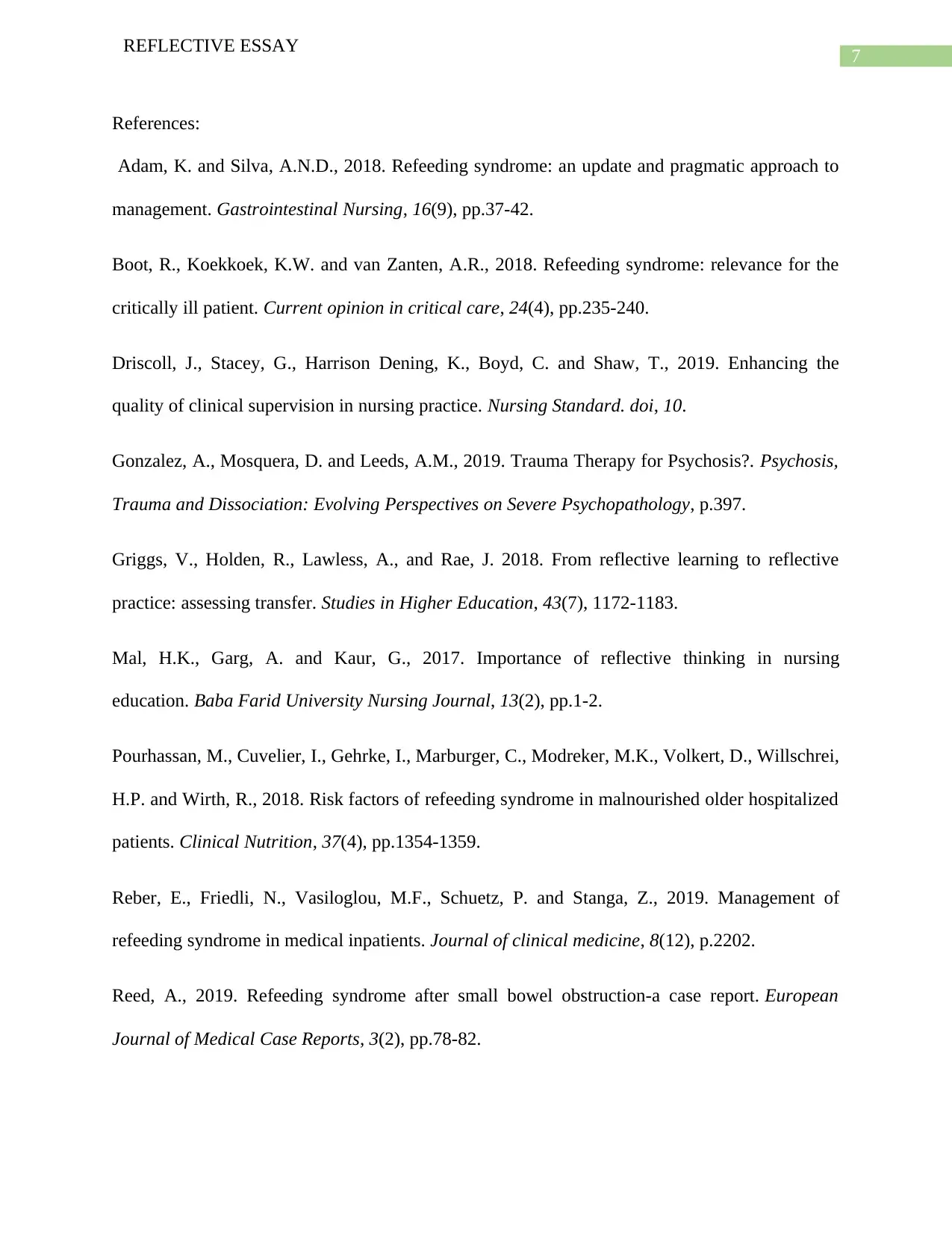
7
REFLECTIVE ESSAY
References:
Adam, K. and Silva, A.N.D., 2018. Refeeding syndrome: an update and pragmatic approach to
management. Gastrointestinal Nursing, 16(9), pp.37-42.
Boot, R., Koekkoek, K.W. and van Zanten, A.R., 2018. Refeeding syndrome: relevance for the
critically ill patient. Current opinion in critical care, 24(4), pp.235-240.
Driscoll, J., Stacey, G., Harrison Dening, K., Boyd, C. and Shaw, T., 2019. Enhancing the
quality of clinical supervision in nursing practice. Nursing Standard. doi, 10.
Gonzalez, A., Mosquera, D. and Leeds, A.M., 2019. Trauma Therapy for Psychosis?. Psychosis,
Trauma and Dissociation: Evolving Perspectives on Severe Psychopathology, p.397.
Griggs, V., Holden, R., Lawless, A., and Rae, J. 2018. From reflective learning to reflective
practice: assessing transfer. Studies in Higher Education, 43(7), 1172-1183.
Mal, H.K., Garg, A. and Kaur, G., 2017. Importance of reflective thinking in nursing
education. Baba Farid University Nursing Journal, 13(2), pp.1-2.
Pourhassan, M., Cuvelier, I., Gehrke, I., Marburger, C., Modreker, M.K., Volkert, D., Willschrei,
H.P. and Wirth, R., 2018. Risk factors of refeeding syndrome in malnourished older hospitalized
patients. Clinical Nutrition, 37(4), pp.1354-1359.
Reber, E., Friedli, N., Vasiloglou, M.F., Schuetz, P. and Stanga, Z., 2019. Management of
refeeding syndrome in medical inpatients. Journal of clinical medicine, 8(12), p.2202.
Reed, A., 2019. Refeeding syndrome after small bowel obstruction-a case report. European
Journal of Medical Case Reports, 3(2), pp.78-82.
REFLECTIVE ESSAY
References:
Adam, K. and Silva, A.N.D., 2018. Refeeding syndrome: an update and pragmatic approach to
management. Gastrointestinal Nursing, 16(9), pp.37-42.
Boot, R., Koekkoek, K.W. and van Zanten, A.R., 2018. Refeeding syndrome: relevance for the
critically ill patient. Current opinion in critical care, 24(4), pp.235-240.
Driscoll, J., Stacey, G., Harrison Dening, K., Boyd, C. and Shaw, T., 2019. Enhancing the
quality of clinical supervision in nursing practice. Nursing Standard. doi, 10.
Gonzalez, A., Mosquera, D. and Leeds, A.M., 2019. Trauma Therapy for Psychosis?. Psychosis,
Trauma and Dissociation: Evolving Perspectives on Severe Psychopathology, p.397.
Griggs, V., Holden, R., Lawless, A., and Rae, J. 2018. From reflective learning to reflective
practice: assessing transfer. Studies in Higher Education, 43(7), 1172-1183.
Mal, H.K., Garg, A. and Kaur, G., 2017. Importance of reflective thinking in nursing
education. Baba Farid University Nursing Journal, 13(2), pp.1-2.
Pourhassan, M., Cuvelier, I., Gehrke, I., Marburger, C., Modreker, M.K., Volkert, D., Willschrei,
H.P. and Wirth, R., 2018. Risk factors of refeeding syndrome in malnourished older hospitalized
patients. Clinical Nutrition, 37(4), pp.1354-1359.
Reber, E., Friedli, N., Vasiloglou, M.F., Schuetz, P. and Stanga, Z., 2019. Management of
refeeding syndrome in medical inpatients. Journal of clinical medicine, 8(12), p.2202.
Reed, A., 2019. Refeeding syndrome after small bowel obstruction-a case report. European
Journal of Medical Case Reports, 3(2), pp.78-82.
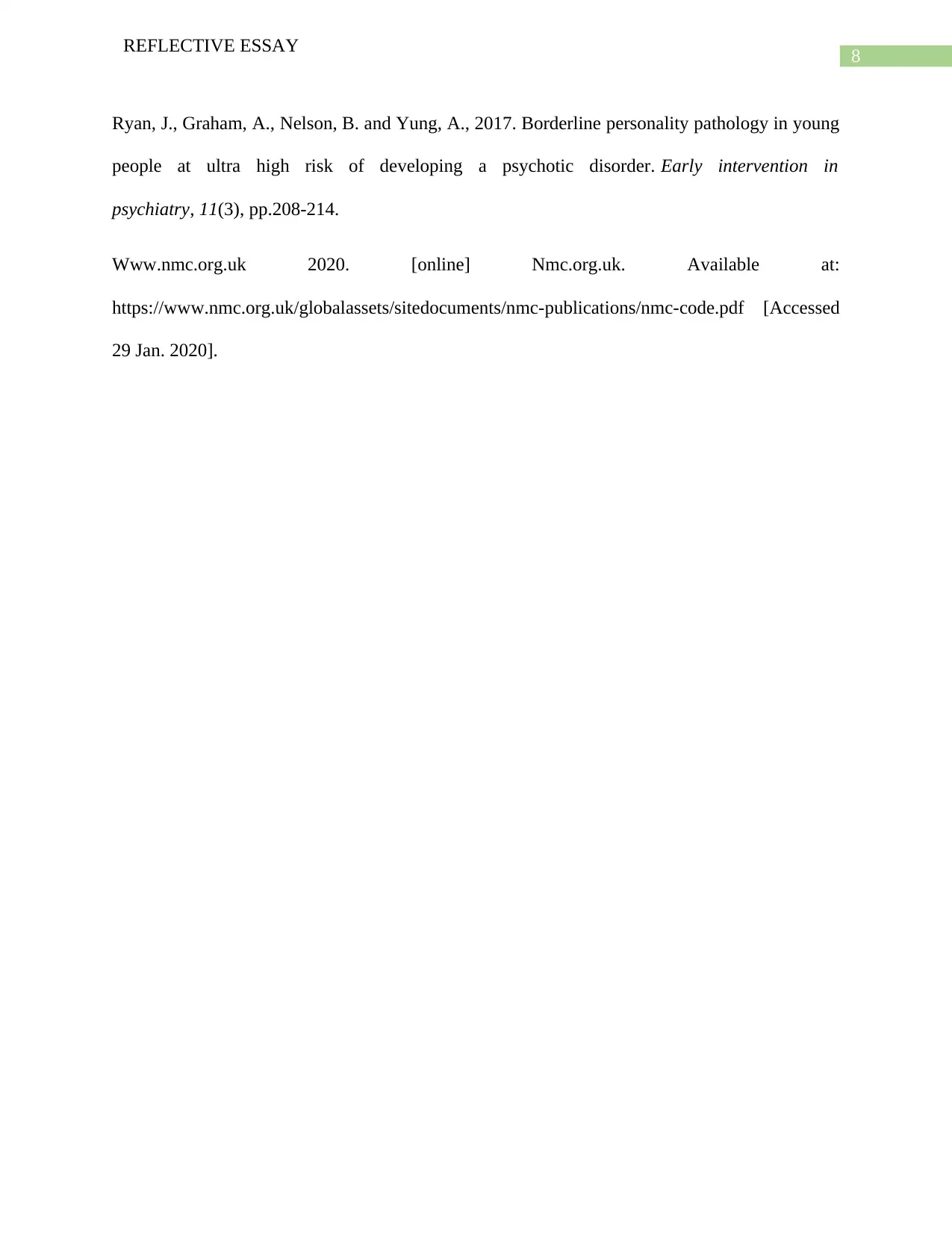
8
REFLECTIVE ESSAY
Ryan, J., Graham, A., Nelson, B. and Yung, A., 2017. Borderline personality pathology in young
people at ultra high risk of developing a psychotic disorder. Early intervention in
psychiatry, 11(3), pp.208-214.
Www.nmc.org.uk 2020. [online] Nmc.org.uk. Available at:
https://www.nmc.org.uk/globalassets/sitedocuments/nmc-publications/nmc-code.pdf [Accessed
29 Jan. 2020].
REFLECTIVE ESSAY
Ryan, J., Graham, A., Nelson, B. and Yung, A., 2017. Borderline personality pathology in young
people at ultra high risk of developing a psychotic disorder. Early intervention in
psychiatry, 11(3), pp.208-214.
Www.nmc.org.uk 2020. [online] Nmc.org.uk. Available at:
https://www.nmc.org.uk/globalassets/sitedocuments/nmc-publications/nmc-code.pdf [Accessed
29 Jan. 2020].
⊘ This is a preview!⊘
Do you want full access?
Subscribe today to unlock all pages.

Trusted by 1+ million students worldwide
1 out of 9
Related Documents
Your All-in-One AI-Powered Toolkit for Academic Success.
+13062052269
info@desklib.com
Available 24*7 on WhatsApp / Email
![[object Object]](/_next/static/media/star-bottom.7253800d.svg)
Unlock your academic potential
Copyright © 2020–2025 A2Z Services. All Rights Reserved. Developed and managed by ZUCOL.





